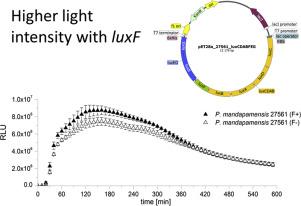当前位置:
X-MOL 学术
›
J. Photochem. Photobiol. B Biol.
›
论文详情
Our official English website, www.x-mol.net, welcomes your feedback! (Note: you will need to create a separate account there.)
The impact of LuxF on light intensity in bacterial bioluminescence.
Journal of Photochemistry and Photobiology B: Biology ( IF 5.4 ) Pub Date : 2020-04-09 , DOI: 10.1016/j.jphotobiol.2020.111881 Eveline Brodl 1 , Alexandra Csamay 1 , Christina Horn 1 , Johannes Niederhauser 1 , Hansjörg Weber 2 , Peter Macheroux 1
Journal of Photochemistry and Photobiology B: Biology ( IF 5.4 ) Pub Date : 2020-04-09 , DOI: 10.1016/j.jphotobiol.2020.111881 Eveline Brodl 1 , Alexandra Csamay 1 , Christina Horn 1 , Johannes Niederhauser 1 , Hansjörg Weber 2 , Peter Macheroux 1
Affiliation

|
The enzymes involved in bacterial bioluminescence are encoded in the lux operon with a conserved gene order of luxCDABEG. Some photobacterial strains carry an additional gene, termed luxF, which produces the LuxF protein, whose function and influence on bacterial bioluminescence is still uncertain. The LuxF protein binds the flavin derivative 6-(3'-(R)-myristyl)-flavin mononucleotide (myrFMN), which is generated as a side product in the luciferase-catalyzed reaction. This study utilized an Escherichia coli (E. coli) based lux operon expression system where the lux operons of Photobacterium leiognathi subsp. mandapamensis 27561 or of Photobacterium leiognathi subsp. leiognathi 25521, namely luxCDAB(F)EG, were cloned into a single expression vector. Exclusion of luxF gene from the lux operon enabled novel insights into the role of LuxF protein in light emission. E. coli cultures harboring and expressing the genes of the lux operon including luxF gene emit more light than without luxF gene. Furthermore, isolation of the tightly bound flavin derivative revealed the presence of at least three different flavin derivatives. Analysis by UV/Vis absorption and NMR spectroscopy as well as mass spectrometry showed that the flavin derivatives bear fatty acids of various chain lengths. This distribution of FMN derivatives is vastly different to what was found in bioluminescent bacteria and indicates that the luciferase is supplied with a range of aldehyde substrates in E. coli.
中文翻译:

LuxF对细菌生物发光中光强度的影响。
涉及细菌生物发光的酶在lux操纵子中以luxCDABEG的保守基因顺序编码。一些光致细菌菌株携带另外一个称为luxF的基因,该基因产生LuxF蛋白,其功能和对细菌生物发光的影响尚不确定。LuxF蛋白与黄素衍生物6-(3'-(R)-肉豆蔻基)-黄素单核苷酸(myrFMN)结合,后者是萤光素酶催化反应中的副产物。这项研究利用了一种基于大肠杆菌(E. coli)的勒克斯操纵子表达系统,该系统中的光细菌Leiognathi亚种为勒克斯操纵子。mandapamensis 27561或Leiognathi细菌亚种。将leiognathi 25521(即luxCDAB(F)EG)克隆到单个表达载体中。从lux操纵子中排除luxF基因,使人们对LuxF蛋白在发光中的作用有了新的认识。包含和表达lux操纵子基因(包括luxF基因)的大肠杆菌培养物比没有luxF基因的细菌培养出更多的光。此外,紧密结合的黄素衍生物的分离显示存在至少三种不同的黄素衍生物。通过UV / Vis吸收,NMR光谱以及质谱分析,表明黄素衍生物带有各种链长的脂肪酸。FMN衍生物的这种分布与生物发光细菌中的分布有很大不同,这表明萤光素酶在大肠杆菌中提供了一系列醛底物。包含和表达lux操纵子基因(包括luxF基因)的大肠杆菌培养物比没有luxF基因的细菌发光更多。此外,紧密结合的黄素衍生物的分离显示存在至少三种不同的黄素衍生物。通过UV / Vis吸收,NMR光谱以及质谱分析,表明黄素衍生物带有各种链长的脂肪酸。FMN衍生物的这种分布与生物发光细菌中的分布有很大不同,这表明萤光素酶在大肠杆菌中提供了一系列醛底物。包含和表达lux操纵子基因(包括luxF基因)的大肠杆菌培养物比没有luxF基因的细菌发光更多。此外,紧密结合的黄素衍生物的分离显示存在至少三种不同的黄素衍生物。通过UV / Vis吸收,NMR光谱以及质谱分析,表明黄素衍生物带有各种链长的脂肪酸。FMN衍生物的这种分布与生物发光细菌中的分布有很大不同,这表明荧光素酶在大肠杆菌中提供了一系列醛底物。通过UV / Vis吸收,NMR光谱以及质谱分析,表明黄素衍生物带有各种链长的脂肪酸。FMN衍生物的这种分布与生物发光细菌中的分布有很大不同,这表明萤光素酶在大肠杆菌中提供了一系列醛底物。通过UV / Vis吸收,NMR光谱以及质谱分析,表明黄素衍生物带有各种链长的脂肪酸。FMN衍生物的这种分布与生物发光细菌中的分布有很大不同,这表明荧光素酶在大肠杆菌中提供了一系列醛底物。
更新日期:2020-04-09
中文翻译:

LuxF对细菌生物发光中光强度的影响。
涉及细菌生物发光的酶在lux操纵子中以luxCDABEG的保守基因顺序编码。一些光致细菌菌株携带另外一个称为luxF的基因,该基因产生LuxF蛋白,其功能和对细菌生物发光的影响尚不确定。LuxF蛋白与黄素衍生物6-(3'-(R)-肉豆蔻基)-黄素单核苷酸(myrFMN)结合,后者是萤光素酶催化反应中的副产物。这项研究利用了一种基于大肠杆菌(E. coli)的勒克斯操纵子表达系统,该系统中的光细菌Leiognathi亚种为勒克斯操纵子。mandapamensis 27561或Leiognathi细菌亚种。将leiognathi 25521(即luxCDAB(F)EG)克隆到单个表达载体中。从lux操纵子中排除luxF基因,使人们对LuxF蛋白在发光中的作用有了新的认识。包含和表达lux操纵子基因(包括luxF基因)的大肠杆菌培养物比没有luxF基因的细菌培养出更多的光。此外,紧密结合的黄素衍生物的分离显示存在至少三种不同的黄素衍生物。通过UV / Vis吸收,NMR光谱以及质谱分析,表明黄素衍生物带有各种链长的脂肪酸。FMN衍生物的这种分布与生物发光细菌中的分布有很大不同,这表明萤光素酶在大肠杆菌中提供了一系列醛底物。包含和表达lux操纵子基因(包括luxF基因)的大肠杆菌培养物比没有luxF基因的细菌发光更多。此外,紧密结合的黄素衍生物的分离显示存在至少三种不同的黄素衍生物。通过UV / Vis吸收,NMR光谱以及质谱分析,表明黄素衍生物带有各种链长的脂肪酸。FMN衍生物的这种分布与生物发光细菌中的分布有很大不同,这表明萤光素酶在大肠杆菌中提供了一系列醛底物。包含和表达lux操纵子基因(包括luxF基因)的大肠杆菌培养物比没有luxF基因的细菌发光更多。此外,紧密结合的黄素衍生物的分离显示存在至少三种不同的黄素衍生物。通过UV / Vis吸收,NMR光谱以及质谱分析,表明黄素衍生物带有各种链长的脂肪酸。FMN衍生物的这种分布与生物发光细菌中的分布有很大不同,这表明荧光素酶在大肠杆菌中提供了一系列醛底物。通过UV / Vis吸收,NMR光谱以及质谱分析,表明黄素衍生物带有各种链长的脂肪酸。FMN衍生物的这种分布与生物发光细菌中的分布有很大不同,这表明萤光素酶在大肠杆菌中提供了一系列醛底物。通过UV / Vis吸收,NMR光谱以及质谱分析,表明黄素衍生物带有各种链长的脂肪酸。FMN衍生物的这种分布与生物发光细菌中的分布有很大不同,这表明荧光素酶在大肠杆菌中提供了一系列醛底物。


























 京公网安备 11010802027423号
京公网安备 11010802027423号